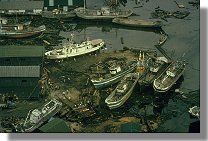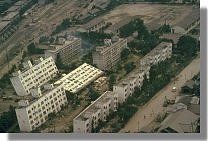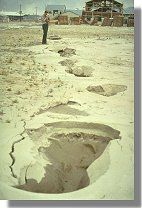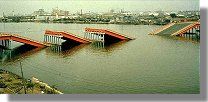|
|
|
1964 Niigata earthquake, Japan
|
The Niigata earthquake of June 16, 1964 had
a magnitude of 7.5 and caused severe damage to many structures in Niigata.
 The destruction was observed to be largely limited to buildings that were founded on top of
loose, saturated soil deposits. Even though about 2000 houses were totally destroyed,
only 28 lives were lost
(General report on the Niigata earthquake 1964). A
tsunami, triggered by movement of the sea floor associated with the fault rupture,
totally destroyed the port of Niigata.
The destruction was observed to be largely limited to buildings that were founded on top of
loose, saturated soil deposits. Even though about 2000 houses were totally destroyed,
only 28 lives were lost
(General report on the Niigata earthquake 1964). A
tsunami, triggered by movement of the sea floor associated with the fault rupture,
totally destroyed the port of Niigata.
|
Liquefaction
The Niigata earthquake, together with the Alaska
earthquake also of 1964, brought
 liquefaction phenomena and their devastating effects to the attention of engineers and
seismologists. A remarkable ground failure occurred near the Shinano river bank where
the Kawagishi-cho apartment buildings suffered bearing capacity failures and tilted
severely (left). Despite the extreme tilting, the buildings themselves suffered
remarkably little structural damage.
liquefaction phenomena and their devastating effects to the attention of engineers and
seismologists. A remarkable ground failure occurred near the Shinano river bank where
the Kawagishi-cho apartment buildings suffered bearing capacity failures and tilted
severely (left). Despite the extreme tilting, the buildings themselves suffered
remarkably little structural damage.
|
|
 Sand boils (right,
SC) and ground
fissures were observed at various sites in Niigata. Lateral spreading caused the
foundations of the Showa bridge to move laterally so much that the simply supported spans became
unseated and collapsed (below, SC).
Sand boils (right,
SC) and ground
fissures were observed at various sites in Niigata. Lateral spreading caused the
foundations of the Showa bridge to move laterally so much that the simply supported spans became
unseated and collapsed (below, SC).

|
|
|





